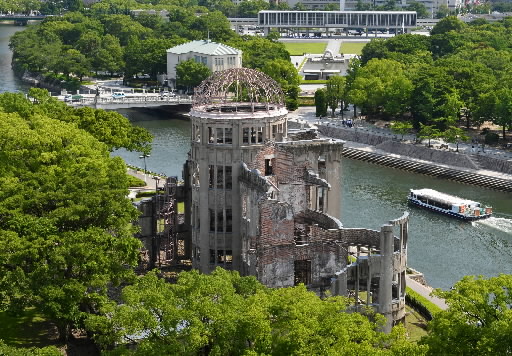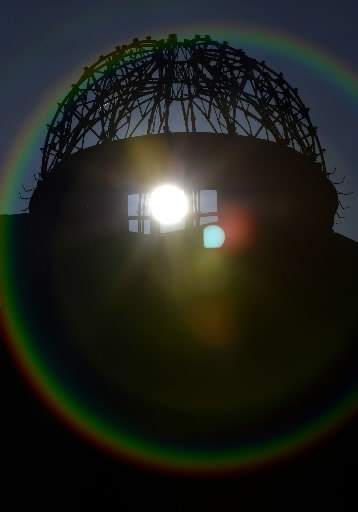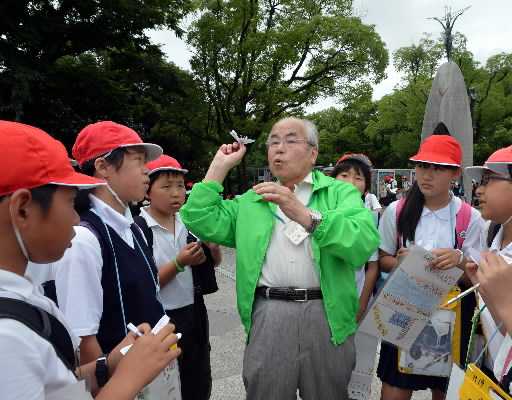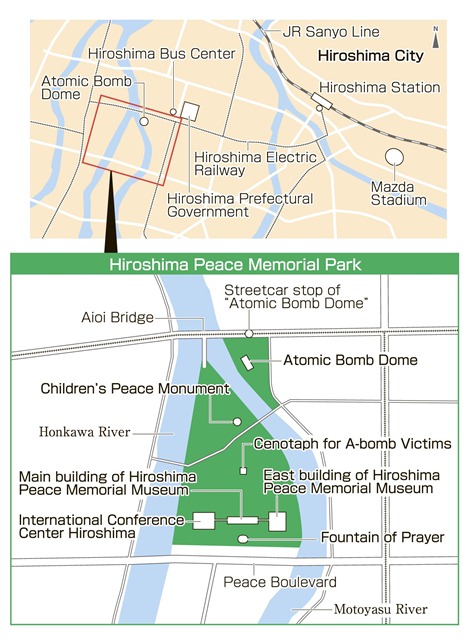Visiting a World Heritage Site: A-bomb Dome (Hiroshima)
Jun. 9, 2013
by Masaki Kadowaki, Staff Writer
Photos by Hajime Araki
The steel beams of the A-Bomb Dome, which once formed an oval-shaped roof, cast distorted shadows on its brick walls under the midsummer sun. The dome is the symbol of Hiroshima, the first city to experience an atomic bombing. It demonstrates not only the cruelty of the atom but also the ability to withstand it.
At 8:15 a.m. on August 6, 1945, the uranium-type atomic bomb “Little Boy” exploded 600 meters above the ground about 160 meters southeast of the dome. The terrific blast and intense thermal rays destroyed downtown Hiroshima, and by late December of that year an estimated 130,000 to 150,000 people were dead.
◇
A tourist was taking a video of the A-bomb Dome. It was the first visit to Hiroshima by the 30-year-old woman, who runs a bakery in the state of Iowa in the United States. She said that when looking up she felt as if something was about to fall from the sky, and she sensed a strong message at the site of the dome.
Her husband, 34, said that although the bomb was dropped by their country, the bombing couldn’t be dismissed as merely a “consequence of the war.” He was impressed by the many buildings in the vicinity of the dome and the city’s recovery, which he described as “unbelievable.”
The A-bomb Dome was built in 1915 as the Hiroshima Prefectural Commercial Exhibition Hall. Its name was later changed, and at the time of the bombing it was known as the Hiroshima Prefectural Industrial Promotion Hall. The five-story steel-frame structure was partially made of brick. Various fairs and exhibitions were held there. The spiral staircase inside and the garden with its fountain were popular play areas for local children. The fountain’s seven stone pillars remain.
Hiroshima resident Yoshiko Yoneda, 76, was taking a break on a bench facing the avenue where streetcars run. She lost her mother, brother, sister and grandmother in the atomic bombing. She had been evacuated outside the city, but returned to search for her family members two days after the bombing and was exposed to radiation.
When she was around 8 years old she and her family visited the Industrial Promotion Hall. “There were a lot of beautiful books there. It was like a library,” she said. “The spiral staircase was unusual, and I ran all the way up to the top.” This happy scene is etched in Ms. Yoneda’s memory along with her recollections of her mother and siblings.
Now she works for the city’s so-called “Silver Human Resources Center” twice a week cleaning up the Peace Memorial Park, where the A-bomb dome is located. “Cleaning up this site is a way of paying my respects not only to my family but also to the many others who died,” she said.
◇
When viewed from the south end of the park against the backdrop of the Fountain of Prayer, the dome is in a direct line with the Peace Memorial Museum and the memorial cenotaph. This concept was incorporated into the park’s design when it was created by architect Kenzo Tange (1913-2005), who later achieved worldwide fame. Mr. Tange said that as the heart of the city of peace he wanted the park to be a place where people from around the world could offer their prayers.
Just as he intended, every year on August 6 the Peace Memorial Ceremony is held in the park. Blown on the breeze, spray from the fountain cools the audience. The ceremony will be held once again this year.
The Hiroshima Peace Volunteers offer free guided tours of Peace Memorial Park including the A-bomb Dome and the memorial cenotaph. One of the volunteers is Hiroshima resident Shoso Kawamoto, 78, an atomic bomb survivor. For the past seven years he has been handing out paper airplanes carrying a folded paper crane to children who visit the park on school excursions or for peace education. Mr. Kawamoto’s mother Satsuki, who died in the atomic bombing at the age of 39, taught him how to fold the airplane.
Mr. Kawamoto was 11 years old at the time of the bombing. He lost his parents and four brothers and sisters. Struggling to survive, he collected scrap iron and picked up cigarette butts near Hiroshima Station. When he was 23 he had a chance to marry, but the woman’s parents strongly opposed the marriage saying to him, “You’re an A-bomb survivor. You won’t live long, will you?” Mr. Kawamoto gave up on marrying and having a family.
He began serving as a guide in 2005. He was inspired to do so when he visited the Peace Memorial Museum for the first time in 2004 and discovered that there were almost no materials on children who had been orphaned by the bombing. He felt it was his mission to convey his experiences.
Thinking of his friends who lost their lives in the bombing and other orphans who sometimes gazed sadly up at the sky, Mr. Kawamoto recalled his mother and began folding paper airplanes. “I fly them for those children,” he said.
There are currently 197 peace volunteers ranging in age from 21 to 85. Of these, 34 are atomic bomb survivors. Guided tours are offered daily between 9 a.m. and 5 p.m. with the exception of the year-end and New Year holidays. Reservations may be made at the Peace Memorial Museum. To make a reservation by phone, call the city’s Education Department at (082) 541-5544.
A-bomb Dome
The A-bomb Dome is located at the foot of the Aioi Bridge, which was the target of the bomb. All of the 30 people who were inside the building are believed to have been killed instantly. In June 1995, 50 years after the bombing, the building was designated a national historical site, and in December of the following year it was inscribed as a UNESCO World Heritage Site (cultural heritage). The City of Hiroshima did preservation work on the dome in 1967, 1989 and 2002.
Directions
The A-bomb Dome is 15 minutes by streetcar from JR Hiroshima Station or a 5-minute walk from the Hiroshima Bus Center. A 50-minute boat ride takes visitors from the riverbank near the A-bomb Dome to a dock near Itsukushima Shrine in Miyajima-cho, Hatsukaichi, the other World Heritage Site (cultural heritage) in Hiroshima Prefecture. There are up to 12 round trips a day.
(Originally published on July 22, 2012)
Photos by Hajime Araki
Cruelty of the atom reflected in steel frame
The steel beams of the A-Bomb Dome, which once formed an oval-shaped roof, cast distorted shadows on its brick walls under the midsummer sun. The dome is the symbol of Hiroshima, the first city to experience an atomic bombing. It demonstrates not only the cruelty of the atom but also the ability to withstand it.
At 8:15 a.m. on August 6, 1945, the uranium-type atomic bomb “Little Boy” exploded 600 meters above the ground about 160 meters southeast of the dome. The terrific blast and intense thermal rays destroyed downtown Hiroshima, and by late December of that year an estimated 130,000 to 150,000 people were dead.
◇
A tourist was taking a video of the A-bomb Dome. It was the first visit to Hiroshima by the 30-year-old woman, who runs a bakery in the state of Iowa in the United States. She said that when looking up she felt as if something was about to fall from the sky, and she sensed a strong message at the site of the dome.
Her husband, 34, said that although the bomb was dropped by their country, the bombing couldn’t be dismissed as merely a “consequence of the war.” He was impressed by the many buildings in the vicinity of the dome and the city’s recovery, which he described as “unbelievable.”
The A-bomb Dome was built in 1915 as the Hiroshima Prefectural Commercial Exhibition Hall. Its name was later changed, and at the time of the bombing it was known as the Hiroshima Prefectural Industrial Promotion Hall. The five-story steel-frame structure was partially made of brick. Various fairs and exhibitions were held there. The spiral staircase inside and the garden with its fountain were popular play areas for local children. The fountain’s seven stone pillars remain.
Hiroshima resident Yoshiko Yoneda, 76, was taking a break on a bench facing the avenue where streetcars run. She lost her mother, brother, sister and grandmother in the atomic bombing. She had been evacuated outside the city, but returned to search for her family members two days after the bombing and was exposed to radiation.
When she was around 8 years old she and her family visited the Industrial Promotion Hall. “There were a lot of beautiful books there. It was like a library,” she said. “The spiral staircase was unusual, and I ran all the way up to the top.” This happy scene is etched in Ms. Yoneda’s memory along with her recollections of her mother and siblings.
Now she works for the city’s so-called “Silver Human Resources Center” twice a week cleaning up the Peace Memorial Park, where the A-bomb dome is located. “Cleaning up this site is a way of paying my respects not only to my family but also to the many others who died,” she said.
◇
When viewed from the south end of the park against the backdrop of the Fountain of Prayer, the dome is in a direct line with the Peace Memorial Museum and the memorial cenotaph. This concept was incorporated into the park’s design when it was created by architect Kenzo Tange (1913-2005), who later achieved worldwide fame. Mr. Tange said that as the heart of the city of peace he wanted the park to be a place where people from around the world could offer their prayers.
Just as he intended, every year on August 6 the Peace Memorial Ceremony is held in the park. Blown on the breeze, spray from the fountain cools the audience. The ceremony will be held once again this year.
Paper airplanes carrying dreams of orphans
The Hiroshima Peace Volunteers offer free guided tours of Peace Memorial Park including the A-bomb Dome and the memorial cenotaph. One of the volunteers is Hiroshima resident Shoso Kawamoto, 78, an atomic bomb survivor. For the past seven years he has been handing out paper airplanes carrying a folded paper crane to children who visit the park on school excursions or for peace education. Mr. Kawamoto’s mother Satsuki, who died in the atomic bombing at the age of 39, taught him how to fold the airplane.
Mr. Kawamoto was 11 years old at the time of the bombing. He lost his parents and four brothers and sisters. Struggling to survive, he collected scrap iron and picked up cigarette butts near Hiroshima Station. When he was 23 he had a chance to marry, but the woman’s parents strongly opposed the marriage saying to him, “You’re an A-bomb survivor. You won’t live long, will you?” Mr. Kawamoto gave up on marrying and having a family.
He began serving as a guide in 2005. He was inspired to do so when he visited the Peace Memorial Museum for the first time in 2004 and discovered that there were almost no materials on children who had been orphaned by the bombing. He felt it was his mission to convey his experiences.
Thinking of his friends who lost their lives in the bombing and other orphans who sometimes gazed sadly up at the sky, Mr. Kawamoto recalled his mother and began folding paper airplanes. “I fly them for those children,” he said.
There are currently 197 peace volunteers ranging in age from 21 to 85. Of these, 34 are atomic bomb survivors. Guided tours are offered daily between 9 a.m. and 5 p.m. with the exception of the year-end and New Year holidays. Reservations may be made at the Peace Memorial Museum. To make a reservation by phone, call the city’s Education Department at (082) 541-5544.
World Heritage Sites
A-bomb Dome
The A-bomb Dome is located at the foot of the Aioi Bridge, which was the target of the bomb. All of the 30 people who were inside the building are believed to have been killed instantly. In June 1995, 50 years after the bombing, the building was designated a national historical site, and in December of the following year it was inscribed as a UNESCO World Heritage Site (cultural heritage). The City of Hiroshima did preservation work on the dome in 1967, 1989 and 2002.
Directions
The A-bomb Dome is 15 minutes by streetcar from JR Hiroshima Station or a 5-minute walk from the Hiroshima Bus Center. A 50-minute boat ride takes visitors from the riverbank near the A-bomb Dome to a dock near Itsukushima Shrine in Miyajima-cho, Hatsukaichi, the other World Heritage Site (cultural heritage) in Hiroshima Prefecture. There are up to 12 round trips a day.
(Originally published on July 22, 2012)











